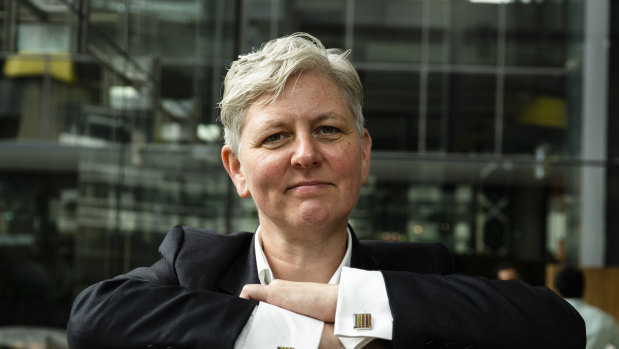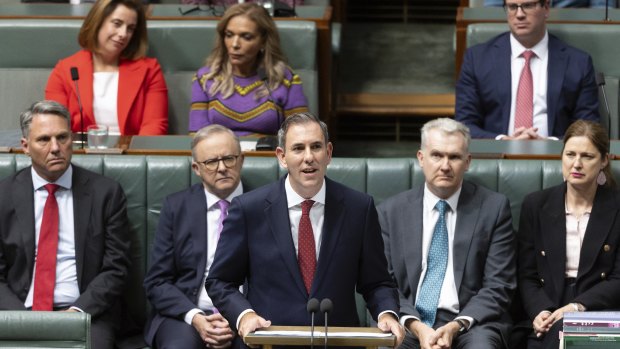This was published 10 months ago
End the creep: Former RBA expert backs annual tax relief for millions
By Shane Wright
A former senior economist for the Reserve Bank has urged an overhaul of the way the federal government taxes income and assets, including an end to bracket creep, while arguing that high interest rates are hitting people who don’t even hold a mortgage.
Westpac chief economist Luci Ellis said on Friday that lifting tax thresholds by 2.5 per cent – the mid-point of the Reserve Bank’s inflation target – each year would help prevent the government’s tax take climbing “forever”.

Westpac chief economist Luci Ellis says while fixed tax rates have the advantage of reducing incomes, and therefore spending, during periods of high inflation, they also have serious drawbacks.Credit: Janie Barrett
But her proposal would cost the federal budget at least $4 billion a year and deliver relatively modest tax cuts to workers while making it tougher for the Reserve Bank and the federal government to control the economy.
The rejigged stage 3 tax cuts, worth more than $23 billion in their first year of operation, begin on July 1. A person earning $100,000 a year will get a $2279 annual, or $44 a week, tax cut.
When announced by the Morrison government, it argued the tax cuts would in effect end bracket creep, which is the process by which a person’s average tax hit increases as their wage lifts.
But even with the cuts, average tax levels will start to climb from 2025-26 because Australia’s tax thresholds are not automatically increased in line with inflation or wage growth.
Ellis said increasing the thresholds by 2.5 per cent a year would offset some of the negative economic impact as the share of tax paid by workers has climbed sharply over recent years.
She said while fixed tax rates had the advantage of reducing incomes, and therefore spending, during periods of high inflation, they also had serious drawbacks.
“As we have seen in Australia recently, it can overdo the negative consumption response to inflation surges, leaving other sectors such as public demand or business investment relatively untouched,” she said.
“Lifting tax thresholds at a fixed rate retains the stabilisation properties of fixed brackets while avoiding the bias to higher taxation over time. Without periodic tax cuts, the share of income paid in tax will rise forever.”
A 2.5 per cent increase in the threshold on the incoming stage 3 tax cuts would lift the tax-free threshold to $18,655 from $18,201 in 2025-26. The 30 per cent tax rate would start at $46,125 instead of $45,001 while the top 45 per cent rate would start at $194,750 instead of $190,000.
The changed thresholds would deliver someone with an annual wage of $100,000 a tax cut of about $400 a year, or $7.70 a week.
Tax cuts would flow to low-income earners as well. Someone on the minimum wage of $45,900 a year would be $303 a year better off.
But the move would be expensive.
Independent economist and budget watcher Chris Richardson said the single-year cost of the change would be at least $4 billion, which would be repeated every year the thresholds were varied.

Treasurer Jim Chalmers delivering the federal budget earlier this month, which included the revamped stage 3 personal tax cuts.Credit: Alex Ellinghausen
Ellis said indexing other prices, such as education fees and subsidised medicines, to 2.5 per cent rather than the consumer price index would also aid the fight against inflation because the current process “propagates a surge in inflation”.
Other parts of the tax system, including government contracts, would also be improved by moving to annual increases of 2.5 per cent, Ellis said, adding that capital gains tax – which is discounted by 50 per cent for assets held for at least 12 months – was ripe for an overhaul.
The government has previously rejected indexing tax thresholds to inflation, a practice last used for 18 months by the Fraser government in the late 1970s. The Coalition has promised to deliver tax reform but has yet to reveal the scope or size.
The Reserve Bank’s minutes of its most recent meeting, released this week, noted that while a small number of households were cutting expenditure because their disposable income had been reduced, many others were “simply choosing to reduce their spending”.
Ellis, who left the Reserve Bank last year, said while the RBA focused heavily on the way interest rates directly affected the spending patterns of people with mortgages, they were also having a broader impact.
She said an apparent increase in household saving levels, which has surprised the RBA, was also affecting the economy by reducing the spending plans of people without mortgages.
“That households plan to save more out of the extra income than in previous episodes should not come as a surprise,” she said.
“One of the main ways that monetary policy dampens demand is by changing the incentive to save versus borrow or spend. It does not need to reduce people’s incomes to change their behaviour.”
The Reserve Bank board next meets on June 17-18.
Cut through the noise of federal politics with news, views and expert analysis. Subscribers can sign up to our weekly Inside Politics newsletter.